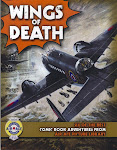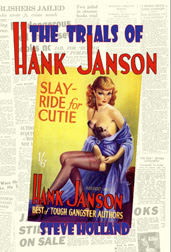
"Trill" was the bizarre pseudonym used on at least two crime novels published in Popular Fiction's Everyday Novels series
circa 1940. The second novel,
The Sickle Murders, I've never seen... but on the evidence of
Removals Limited, that might be for the best.
Removals Limited, is a delightfully lousy yarn starring Doctor Robert Lessing, who has given up his practice in order to help Scotland Yard with their most baffling cases (it appears to be a sequel, perhaps to
The Sickle Murders, despite the fact that the latter appeared later).
The death of a northern industrialist leads Lessing to discover that a series of deaths have been planned by a group known as Removals Limited (a kind of Murder Inc.) who leave their calling card – and all kinds of clues – laying around for Lessing to find. Led by the audacious Baron von Schnapps, Removals Ltd. is obviously clearing up all loose ends and planning to depart this country, but after one murder attempt fails, Lessing fools them into believing he has undergone surgery and is safely out of the picture. Now adopting various disguises he follows the Baron to Hamburg for a final showdown.
Lessing makes some intuitive logic jumps – which always prove correct – in his investigation, first discovering a tricky mechanism for releasing gas that leads the industrialist to poke his head out of a train window just in time to have it shorn off by another train (“the murder has been planned with diabolical exactitude”) then, at dizzying speed, tracking down the culprit who fitted the device – a workman at the shunting yard – via an ebonite box which contained the workman’s nail polish (the well-manicured rail worker is promptly killed), and thence to a bookie (subsequently murdered) and the industrialists son (murdered).
Lessing is a master of disguise, tracking down von Schnapps to “Aunt Mary’s” drinking den, full of the worst scum of London. Disguised as Slim Sankey (“the lousiest sailor as ever breathed”), Lessing infiltrates this low place with the help of his journalist friend Tim and an accent thick enough to stop a bullet – “Where are yer ‘eading for, kid, it’ll be closin’ time ‘ere in ‘alf a minute, me pal an’ me is out for th’ night. What about it? Can yer put us wise to a show-down, somewhere ‘andy like, where we can sup a pint o’ ale an’ maybe ‘ave a dance or two, wi’ a spot o’ recreation thrown in?”
Not long after, tricky Lessing impersonates a German sailor in order to follow von Schnapps: “I couldn’t ‘elp over’earin’ part o’ what you was a-sayin’ to yer swell friend. Yer lookin’ fer a man, ain’t yer?” he asks the ship’s Captain in, er, perfect German.
His investigation in Hamburg goes well until… “It was whilst returning to the hotel that my driver had the misfortune to knock down a woman. The accident was quite unavoidable, as the stupid female stepped off the pavement and walked practically under the front wheels of the cab.”
By sheer luck, the stupid female turns out to hold a clue to how von Schnapps contacts his clients and Lessing is able to persuade the Hamburg police to swoop on van Schnapps.
Lessing is thoroughly British. Everything stops for tea or sandwiches even in the middle of the case; his attitude towards women is completely dismissive and his attitude to foreigners is to order them about. Even his best friends in the British police are sometimes more an inconvenience than an assistance: “Whether the chief was unnerved or merely stupid I do not know,” Lessing reports as the climactic battle with von Schnapps takes place… or seems to, for the Baron has one more trick to play. With Lessing surrounded by so many incompetent folk, if only the Baron had known Morse Code as well he did the geographical distribution of Javanese tribes, he may well have won.
Update: December 2009
Looks like
Removals Limited might have been a sequel after all. Jamie Sturgeon tells me that
The Sickle Murders was first published in hardback (London, Lincoln Williams, 1935). It was produced anonymously, the only credit being to "by the author of
'The Vengeance of ing Ho'"
(sic). Jamie tells me that the book is listed in the
English Catalogue of Books as having appeared in February 1935 and it was listed under the pen-name "Trill".
Looking at the publisher, they appear to be one of those "up like a rocket, down like a stick" library hardcover firms that popped up in the 1930s. Lincoln Williams (Publishers) Ltd. went into administration in July 1935, the petitioner being one Amy Gilmour, who wrote the novel
The Lure of Islam, published by Lincoln Williams in 1933. One imagines that the author of
The Sickle Murders may have received nothing for his efforts and that
The Vengeance of ing Ho might not have appeared, if it was to have been another Lincoln Williams title.
Al Hubin's
Crime Fiction Bibliography (which I
should have checked first!) provides the name of an author: Harry C. Liebart. Now, Liebart is an incredibly uncommon surname in the UK (I think it may have Belgian or French origins). However, I think this is a possible error and the surname should be Liebert (with an 'e')... and a search for Harry Liebert turns up a possible candidate: Harry C. Liebert, born Henry Chapman Liebert in Rochdale on 14 October 1903, died 1978. He was the son of Henry Anton E. Liebert (a mechanical engineer) and his wife Lilian Roussy (
nee Petrie), who were married in Rochdale in 1899.
Harry seems to have lived his early life in the Greater Manchester area: it was there that he married Doris L. Hemmings in 1930 and the couple were living at 60 Conway Road, Sale Moor, around 1936, in which year the first of two children (a daughter, Gloria) were born. The Lieberts then seem to have moved south: in 1938, the phone book has their address as North Cottage, Hadham Ford, Little Hadham, Hertfordshire. A second child, Geoffrey John (or possibly John Geoffrey) was born around that time (perhaps 1939).
Harry C. Liebert then served with the Royal Pioneer Corps, becoming a 2nd Lieutenant on 30 March 1942 and was still serving with them as a Lieutenant in 1949. He was given a Short Service Commission as a Captain in April 1950 and eventually resigned his commission on 11 August 1954.
I believe Liebert lived at South Bank Cottage, Cox Bank, Audlem, near Crewe, Cheshire, in the 1960s and 1970s, before returning to Manchester around 1975 or 1976, and was living at 19 Burlington Road when he died in 1978.
Of course, this does not answer the burning question: Did Harry C. Liebert write any more novels that we're not aware of ? Perhaps his early experience with Lincoln Williams put him off and he simply sold on the paperback rights cheaply to Popular Fiction. Or perhaps he wrote more for Popular Fiction, who were prolific publishers and turned out a lot of anonymous fiction. For now I'm just happy to have a name to attach to the bizarre pseudonym "Trill".
Update: 16 March 2011
A copy of
The Sickle Murders appeared on eBay recently and attracted a winning bid of £106. The high price reflected not only the scarcity of the book and the fact that it was in a dust-jacket but also that it was autographed by the author with the inscription "With Compliments from the Author Harry C. Liebert ("Trill") Feb 1935". And "Trill" was even photographed for the book's frontispiece - "Trill for a Thrill" - wearing a mask to conceal his identity.
The sale confirms a couple of other things:
The Sickle Murders is by "the author of
The Vengeance of Fing Ho., which confirms this third title by this curious author. The seller included a bookmark in the sale which promoted the latter title, which makes me think that it was something that was actually published, although I've yet to find absolute confirmation of its existence.
There's still no trace of any further books from the pen of Harry C. Liebert, but it could easily be that he adopted another pseudonym and kept writing.
A little further digging has turned up a notice for the death of Harry's wife, Doris Lillian Liebert, who lived in Manchester but died after a short stay in Devon on 30 November 2000, aged 90. The notice confirms that they had two children Gloria (who married a Peter and has three children) and Geoffrey (who married a Shirley and also has three children). With any luck, someone from the Liebert family may stumble across this when they're looking into their family tree and get in touch.
 I'm rather pleased that ITV are wheeling out Poirot and Marple over Christmas and New Year. They're still among the best dramas being produced on the TV and in a generally lousy line-up they really stand out on the third channel's schedule.
I'm rather pleased that ITV are wheeling out Poirot and Marple over Christmas and New Year. They're still among the best dramas being produced on the TV and in a generally lousy line-up they really stand out on the third channel's schedule.









































































